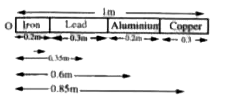A 1m long rod having a constant cross sectional area is made of four materials. The first 0.2m are made of iron, the next 0.3m of lead, the following 0.2m of aluminium and the remaining part is made of copper. Find the centre of mass of the rod. The densities of iron, lead aluminium and copper are 7.9×103kg/m3, 11.4×103kg/m3, 2.7×103kg/m3 and 8.9×103kg/m3 respectively.

mass (m)= volume(v) × density (d)
m= Area(A) × length(l) × density (d)
m=Ald
Mass of iron part, m1=A×0.2×7.9×103
=1.58×103A
Mass of lead part m2=A×0.3×11.4×103
=3.42×103A
Mass of aluminium part, m3=A×0.2×2.7×103
=3.42×103A
Mass of aluminium part, m3=A×0.2×2.7×103
=0.54×103A
Mass of copper part m4=A×0.3×8.9×103
=2.67×103A
Co-ordinate of iron part from end ..O.. of the rod x1=0.1m
Co-ordinate of lead part from end ..O.. of the rod, x2=0.35m
Co-ordinate of aluminium part from end ..O.. of the rod, x3=0.6m
Co-ordinate of copper part from end ..O.. of the rod, x4=0.85m
∴ Centre of mass of the rod,
Xc=m1x1+m2x2+m3x3+m4x4m1+m2+m3+m4
⇒Xcm=(1.58×103×0.1+3.42×103×0.35+0.54×103×0.6+2.67×103×0.85)A(1.58×103+3.42×103+0.54×103+2.67×103)A
⇒Xcm=0.481m from the end "O.. of the rod.
Topper's Solved these Questions
- BOOK - AAKASH SERIESCHAPTER - SYSTEM OF PARTICLES AND ROTATIONAL MOTIONEXERCISE - Exercise-I143videos
SYSTEM OF PARTICLES AND ROTATIONAL MOTION
- BOOK - AAKASH SERIESCHAPTER - SYSTEM OF PARTICLES AND ROTATIONAL MOTIONEXERCISE - Exercise-II109videos
SYSTEM OF PARTICLES AND ROTATIONAL MOTION
- BOOK - AAKASH SERIESCHAPTER - SYSTEM OF PARTICLES AND ROTATIONAL MOTIONEXERCISE - PRACTICE EXERCISE (Rotational Dynamics )17videos
SYSTEM OF PARTICLES AND ROTATIONAL MOTION
- BOOK - AAKASH SERIESCHAPTER - SURFACE TENSIONEXERCISE - ADDITIONAL PRACTICE EXERCISE (PRACTICE SHEET (ADVANCED) INTEGER TYPE QUESTIONS )8videos
SURFACE TENSION
- BOOK - AAKASH SERIESCHAPTER - THERMAL PROPERTIES OF MATTEREXERCISE - ADDITIONAL PRACTICE EXERCISE (LEVEL - II) PRACTICE SHEET (ADVANCED) Integer/Subjective Type Questions2videos
THERMAL PROPERTIES OF MATTER
Similar Questions
A 1m long rod having uniform area of cross section is made of four materials. The first 0.2m is made of iron, the next 0.3m of lead, the following 0.2m of aluminium and the remaining part is made of copper. Find the centre of mass of the rod. The densities of iron, lead, aluminium and copper are 7.9×103kg/m3,11.4×103kg/m3,2.7×103kg/m3and8.9×103kg/3 respectively.
View SolutionThe diameter of an iron wire is 1.20 mm. If the speed of transverse waves in the wire is 50.0m/s, what is the tension in the wire? The density of iron is 7.7×103kg/m3
View Solution
Knowledge Check
- Question 1 - Select One
Two metal spheres are falling through a liquid of density 2×103kg/m3 with the same uniform speed. The material density of sphere 1 and sphere 2 are 8×103kg/m3 and 11×103kg/m3 respectively. The ratio of their radii is :-
A118B√118C32D√32
A sonometer wire of length 1.5m is made of steel. The tension in it produces an elastic strain of 1%. What is the fundamental frequency of steel if density and elasticity of steel are 7.7×103kg/m3 and 2.2×1011N/m2 respectively ?
View SolutionA piece of aluminium of relative density 2.7 floats in mercury. Find the fraction of volume of aluminium piece which remains outside the mercury. The density of mercury is 13.6×103 kg/m3.
View SolutionTwo metal spheres are falling through a liquid of density 2×103kg/m3 with the same uniform speed. The material density of sphere 1 and sphere 2 are 8×103kg/m3 and 11×103kg/m3 respectively. The ratio of their radii is :-
View SolutionCalculate the mass of copper required to draw a wire 5km long having resistance of 5Ω .The density of copper is 8.9×103kgm−3 and resistance of copper is 1.7×10−8Ωm
View SolutionCalculate the speed of a transverse wave in a wire of 1.0mm2 cross-section under a tension of 0.98N. Density of the material of wire is 9.8×103kg/m3
View SolutionCalculate the speed of a transverse wave in a wire of 1.0mm2 cross-section under a tension of 0.98N. Density of the material of wire is 9.8×103kg/m3
View SolutionGiven that resistivity of copper is 1.68×10−8Ωm. Calculate the amount of copper required to draw a wire 10 km long having resistance of 10Ω. The density of copper is 8.9×103kgm−3.
View Solution

